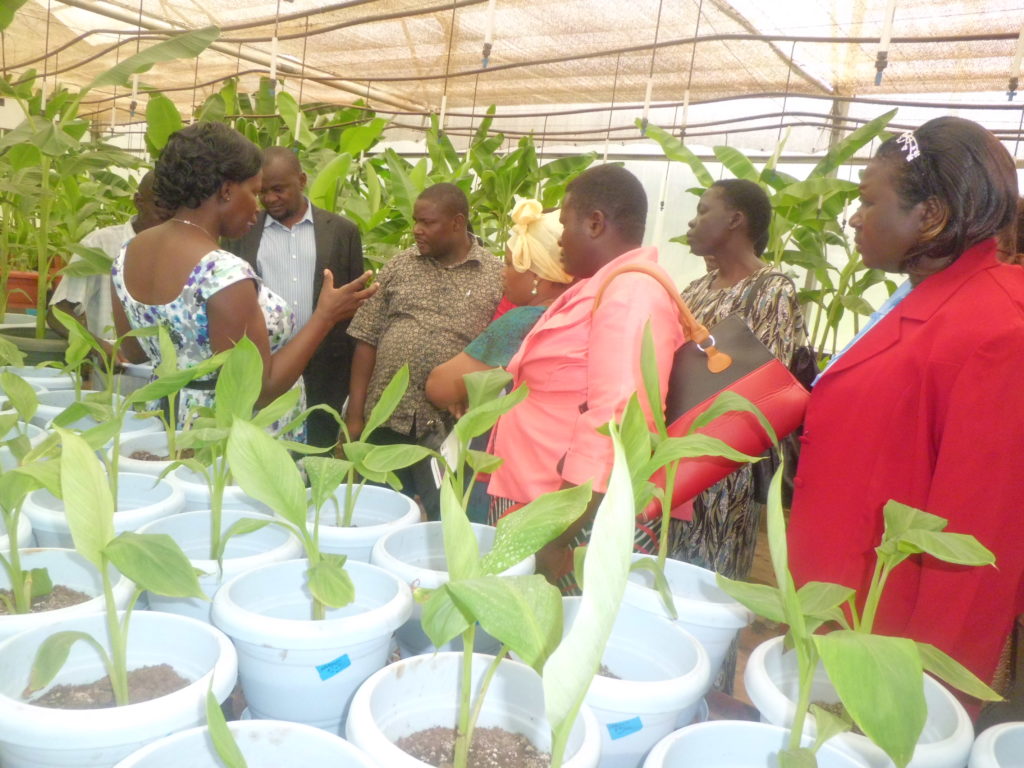Ugandan scientists are eying a 2021 release date for genetically modified bananas fortified with vitamin A, provided the nation passes its biosafety law.
In 2005, Ugandan scientists began using the tools of biotechnology to breed bananas fortified with vitamin A. Their goal was to help rural families suffering from a deficiency of the nutrient, which is essential for proper growth, maintenance of the immune system and good vision.
To date, the 13-year research effort has shown promising results, with the genetically modified (GM) banana variety expressing 100 percent vitamin A content. The fortified variety is a more golden color than ordinary bananas.
Dr. Jerome Kubiruba, head of the banana program at the National Agricultural Research Laboratories (NaRL) in Kawanda, said his team is poised to release the variety by 2021.
“The product is ready,” he said. “We have managed to incorporate vitamin A as we wanted. If given the opportunity to consume it even today, I will be more than willing to do so because the product we have now is good for consumption. Secondly, we have followed the standard research procedure during the breeding process. But there are modalities to secure permission from the responsible committee at Uganda National Council of Science and Technology (UNCST) and other international bodies for this to happen.”
Kubiruba explained that his team has secured a permit from UNCST to conduct multi-locational trials in different geographical locations throughout the country, including Bulindi in Western Uganda, Buginyanya in Eastern Uganda and Kawanda in Central Uganda.
These trials will help to determine the growth vigor of the plants in the various regions so that farmers are given varieties best suited to their agricultural conditions and capable of producing good yields.
The team assumes Uganda’s biotechnology and biosafety law will be operational by 2021 and the GM crops will follow the Ministry of Agriculture’s current procedure for releasing new varieties of conventionally bred crops.

The breeding procedure
Dr. Stephen Buah, program leader for the fortified banana research at NaRL, said the breeding program began when scientists determined that a good number of rural communities, particularly in Western Uganda, are deficient in vitamin A and iron.
Some 28 percent of Uganda’s preschool age children and 23 percent of pregnant women are deficient in vitamin A and iron, according to World Bank statistics. Scientists at NaRL felt it was better to incorporate vitamin A into food, which can be grown by the affected communities and consumed directly, than to encourage pregnant women and mothers to buy vitamin A and iron tablets, especially since they often do not have the resources to buy supplements.
Since banana is a dietary staple for many Ugandans, it was a likely candidate for fortification.
The team accessed genes with beta–carotene from non-edible banana varieties from Southeast Asia. These were isolated and introduced through genetic engineering to two local cultivars, Nakitembe and M9.
There were initially 800 lines at NARL confined field trials. The team selected two lines with traits similar to those of the conventional variety but also with enhanced vitamin A properties.
Buah said his team checked the vitamin content using molecular methods that confirmed the gene exists in the new banana varieties. Further confirmation came from the field trial site because the flesh of the fortified banana is a pinkish color. There is also an orange color expression deep in the leaves, meaning the gene inserted is fully integrated to the plants.
The team has also ensured that the banana plant grows true to the traditional type with the initial traits remaining intact apart from introduction of vitamin A gene.
The Uganda research is comparable to the pioneering work involving the transfer of vitamin A and iron genes into bananas conducted in 2007-2008 at Queensland University of Technology in Australia.
Statistical data
A USAID 2018 report highlighting Uganda’s nutrition profile found that malnutrition arises in children as a result of consuming food lacking vitamin A and iron. It further stated that malnutrition in pregnant women and children has many adverse impacts on a child’s survival and long-term well-being, as well as far-reaching consequences for human capital, economic productivity and national development overall. The figures indicate that 2.2 million children under age 5 suffer from stunting due to limited food and healthcare.
World Bank statistics found that 38 percent of Ugandan children under the age of five are stunted, 16 percent are under weight and 6 percent are wasted, while 14 percent of infants are born with a low birth weight. This is partly due to insufficient vitamin A and iron intake both in the children and expectant mothers.
Additionally, 64 percent of preschool-aged children and 41 percent of pregnant women are anemic.
The report suggested iron-folic acid supplementation of pregnant women, deworming, provision of multiple micronutrient supplements to infants and young children and fortification of staple foods as effective strategies to improve the iron and vitamin A status of these vulnerable subgroups.
